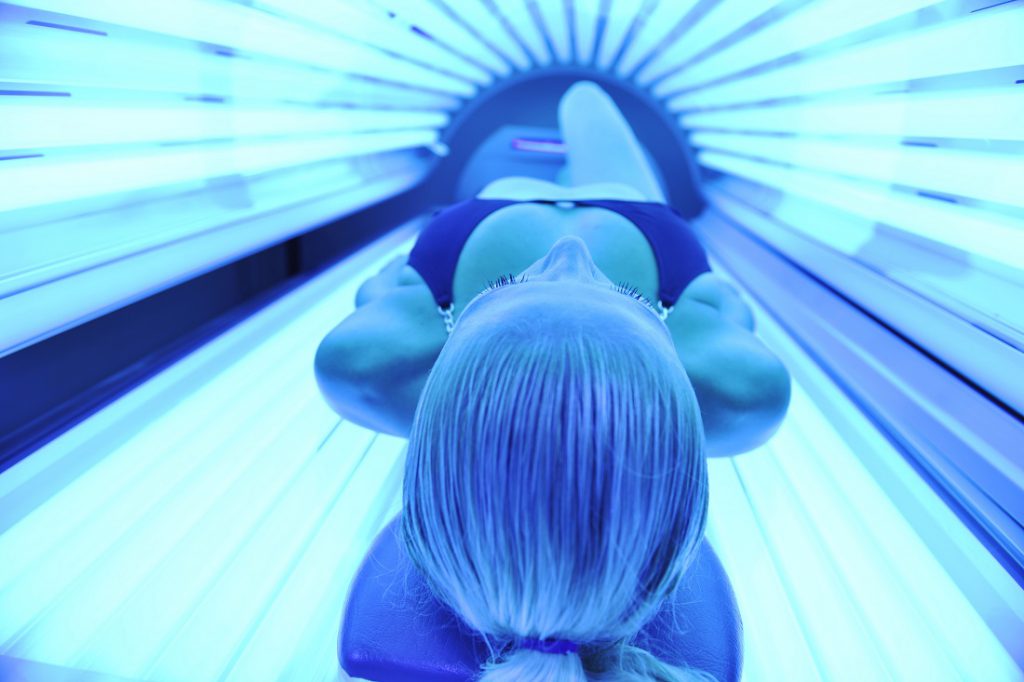Even after hearing that women who have ever been indoor tanning are six times more likely to be diagnosed with melanoma in their 20s than those who have never done so, it’s hard to believe skin cancer can happen at such a young age. Most young indoor tanners probably don’t believe it can happen to them. However, three young women — all diagnosed before the age of 30 — will tell you that it absolutely can.
Kelly, Kaitlin and Kristen all had different experiences with skin cancer — different forms of the disease, different treatments and different relationships with the sun. But the one common denominator was indoor tanning during their teenage years.
Tanning as a Lifestyle

Kristen C. was a self-described sun worshipper throughout her teens. She tanned both outdoors and in tanning salons, always pursuing the bronzed tan she desired.
“I loved how my skin looked, but I had no idea the harm I was doing,” Kristen said. “I know for young women like me who love the beach, it can be hard not to want a nice, golden tan.”
Kristen came to understand the real risks of tanning when she was unexpectedly diagnosed with basal cell carcinoma, the most common form of skin cancer. Indoor tanning may be most closely associated with melanoma, but it affects your chances of developing other skin cancers as well: Any history of indoor tanning increases the risk of developing basal cell carcinoma before age 40 by 69 percent. After having excisional surgery to remove the tumor, Kristen has thankfully remained cancer-free. The experience caused a major shift in her relationship with tanning, however.
“I immediately stopped using tanning beds,” she said. “I still love the sun and the beach, but now I won’t step out without SPF 30. This diagnosis helped me realize that it’s not worth the risk.”
Along with using sunscreen daily, a full sun protection regimen includes covering up with clothing, especially a broad-brimmed hat and UV-protective sunglasses, and seeking shade between the peak sunshine hours of 10 AM and 4 PM.
Infrequent Tanning Is Still Dangerous

Sun lovers and frequent indoor tanners are certainly at an increased risk for developing skin cancer. But it can be difficult to reconcile with the idea that even incidental indoor tanning as a teen can have a serious effect. People who first use a tanning bed before age 35 increase their risk for melanoma by 75 percent.
Whether you were an indoor tanning devotee or can count the number of times you used a tanning bed on one hand, it’s important to be on the lookout for signs of melanoma. Kaitlin A. was hardly a devoted indoor tanner as a teen. She recalls starting to tan at the age of 16, but says she “primarily tanned for dance recitals and school dances like homecoming and prom.”
When she noticed a suspicious spot on her leg, she forced herself to visit the doctor despite a desire to put it off. “In the back of my head, I knew something was wrong,” she recalled. Her instinct was correct: Kaitlin was diagnosed with melanoma, and endured a significant surgery to remove it. Her doctor had to remove a large section of skin from her left thigh, and two lymph nodes.
After that, Kaitlin was committed to keeping an eye on her skin. “I saw my dermatologist for full-body exams every three months for three years, then twice a year for two years after that.”

This kind of vigilance also helped Kelly D., who like Kaitlin, had a history of indoor tanning and was diagnosed with melanoma in her 20s. After her gynecologist noticed a dark freckle on her abdomen, Kelly got herself to her dermatologist’s office. That mole ended up being benign — but at a subsequent routine visit, Kelly called her doctor’s attention to a freckle on her thigh. She had recently noticed it changing, getting bigger, darker and more raised. After a biopsy, Kelly was diagnosed with superficial spreading melanoma which, if left untreated, could have become invasive.
“I can’t even begin to express the importance of self-exams,” Kelly said, adding that her dermatologist admitted she hadn’t thought the spot would be melanoma. “I may have saved my own life!”
Taking Action
Researchers have proven many times that tanning beds expose the skin to unnaturally intense UV rays, the harmful impact of which can’t be overstated. More people develop skin cancer because of tanning than develop lung cancer because of smoking, and sometimes it develops at shockingly young ages.
“Never in a million years did I think I would call myself a cancer survivor at the age of 21,” Kaitlin said. “I live with the terrifying fear that this awful disease could return any day. Ladies, don’t tan!”
Parents also have a role to play in stopping childhood tanning — talk to your teens about the dangers of indoor tanning. And if, like Kristen, your teen can’t resist that bronzed look, there are sunless tanning options available that are much safer than UV tanning.
“I still love how a tan looks, but now I achieve that through tinted lotions and spray-on tans so I can take care of my skin,” Kristen explained.
Whether they decide to rock their natural skin tone or explore sunless tanning, teens can be sure they’re making the right decision for their skin by ditching indoor tanning. Because as Kaitlin, Kristen and Kelly all learned, visiting the tanning bed for years — or even a handful of times — can have consequences that extend beyond your time as a teen.




